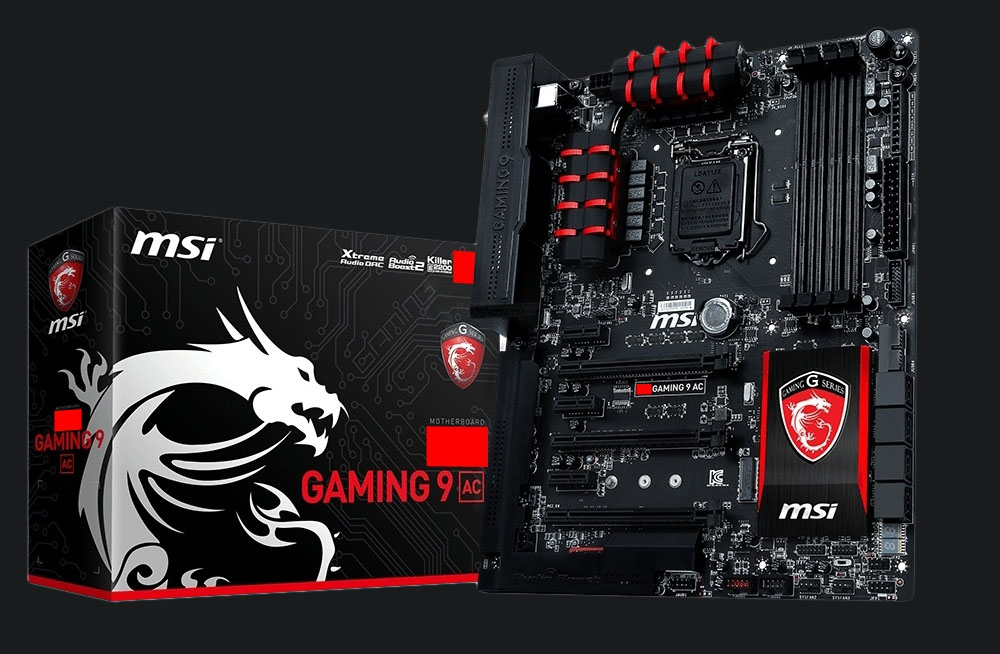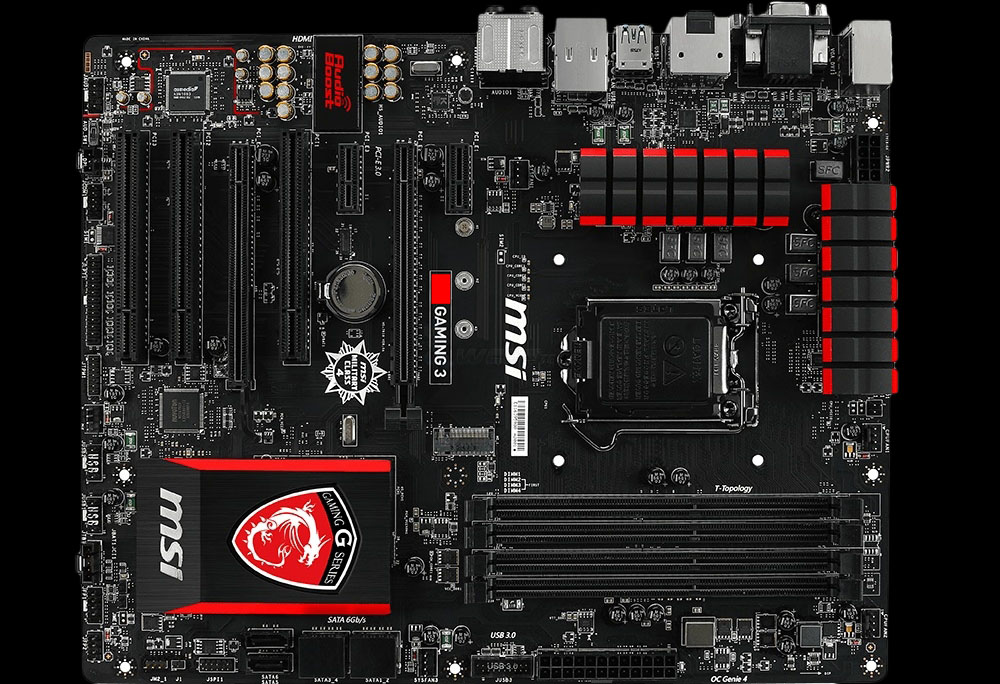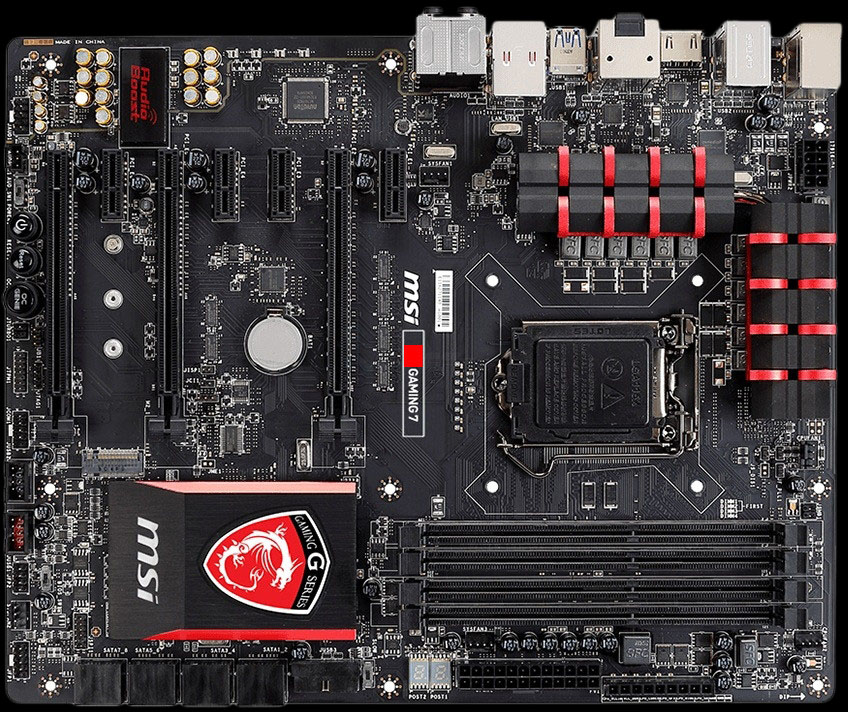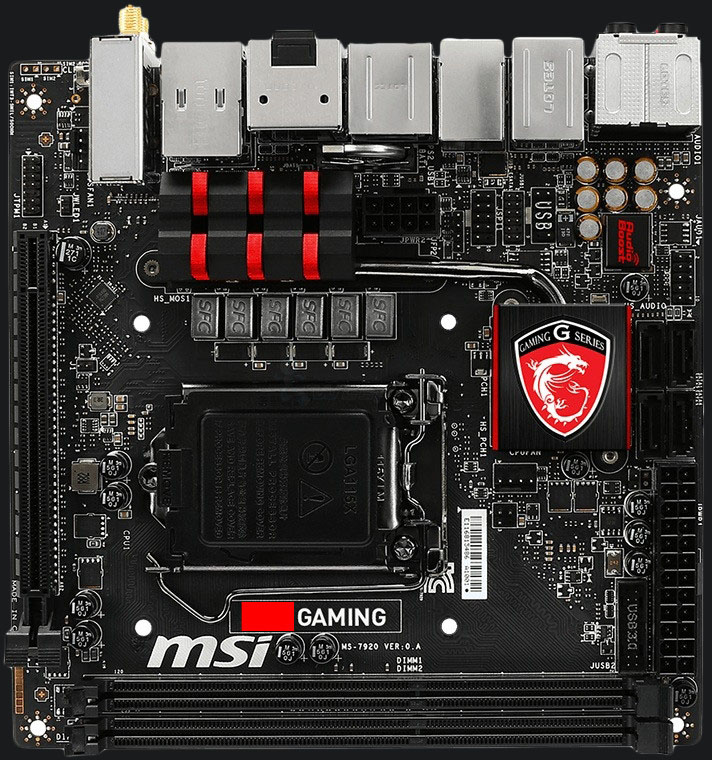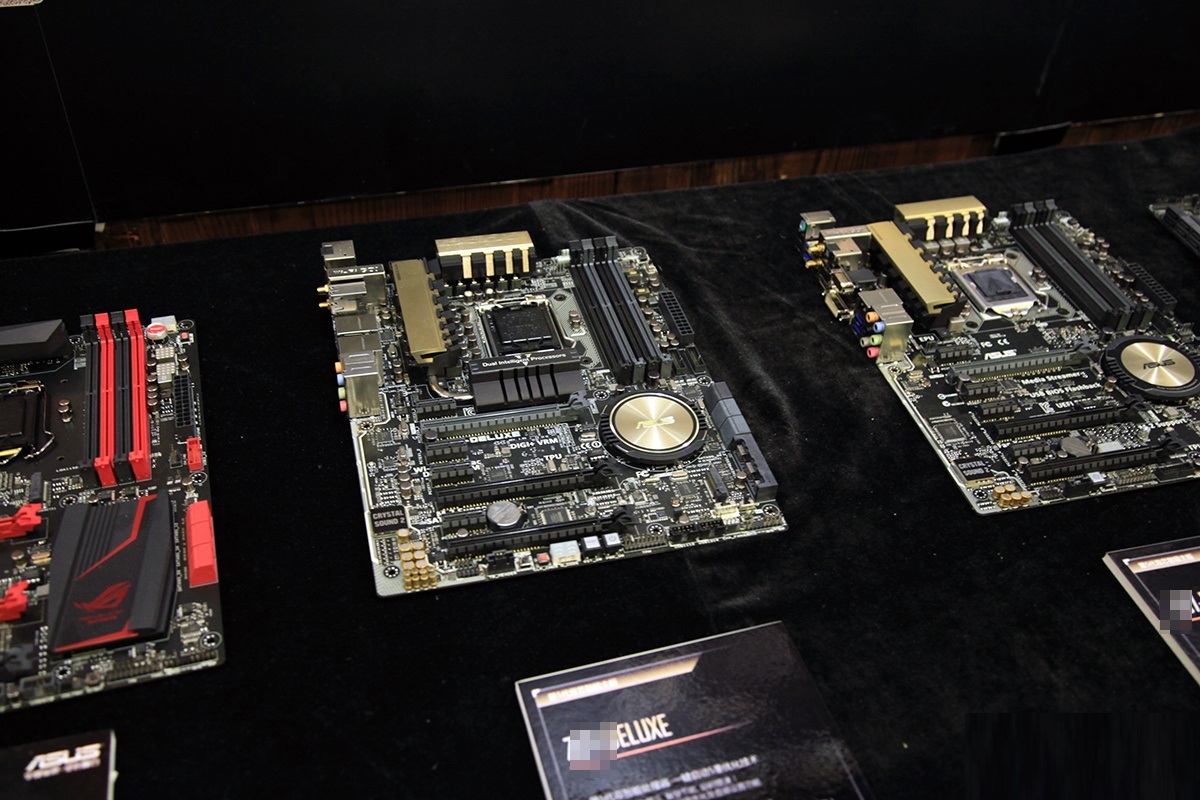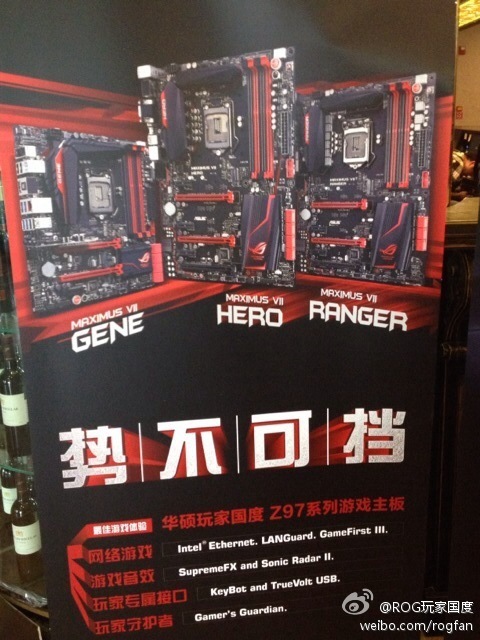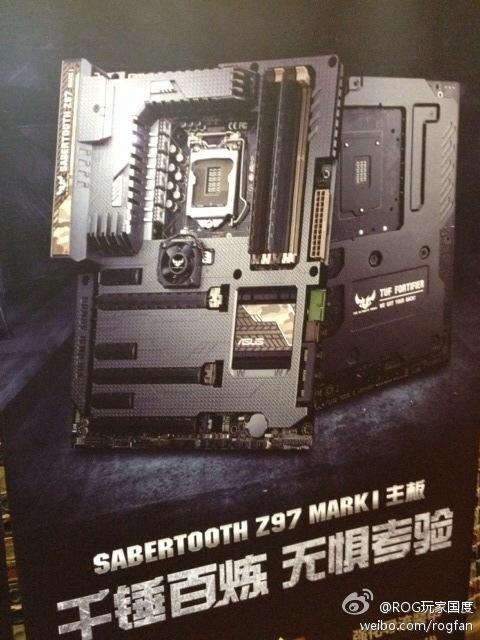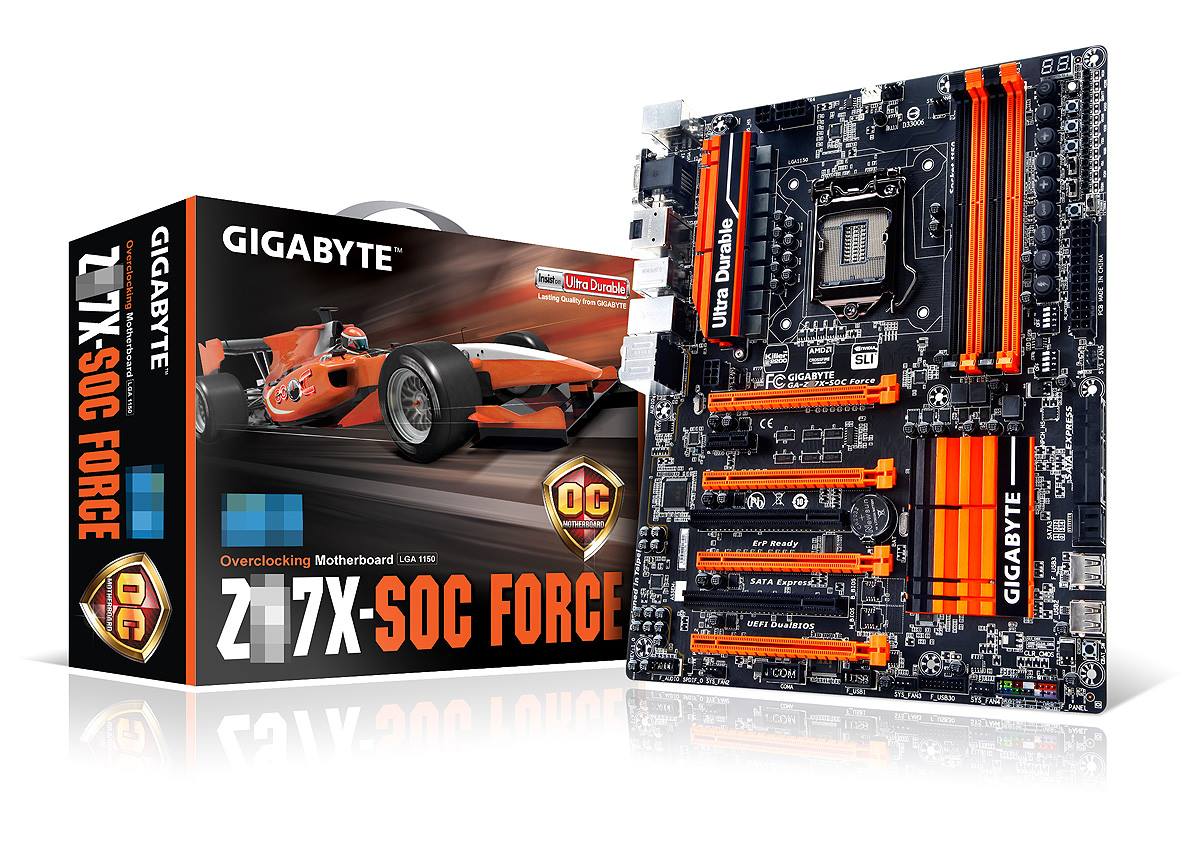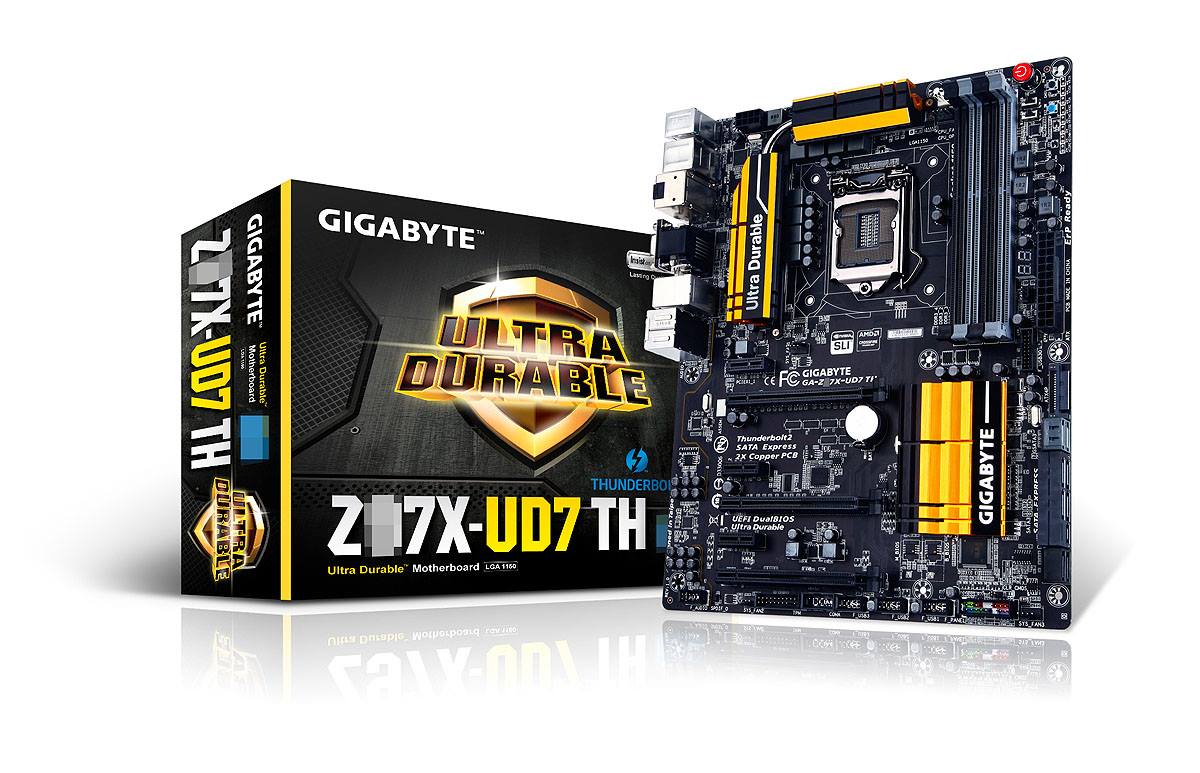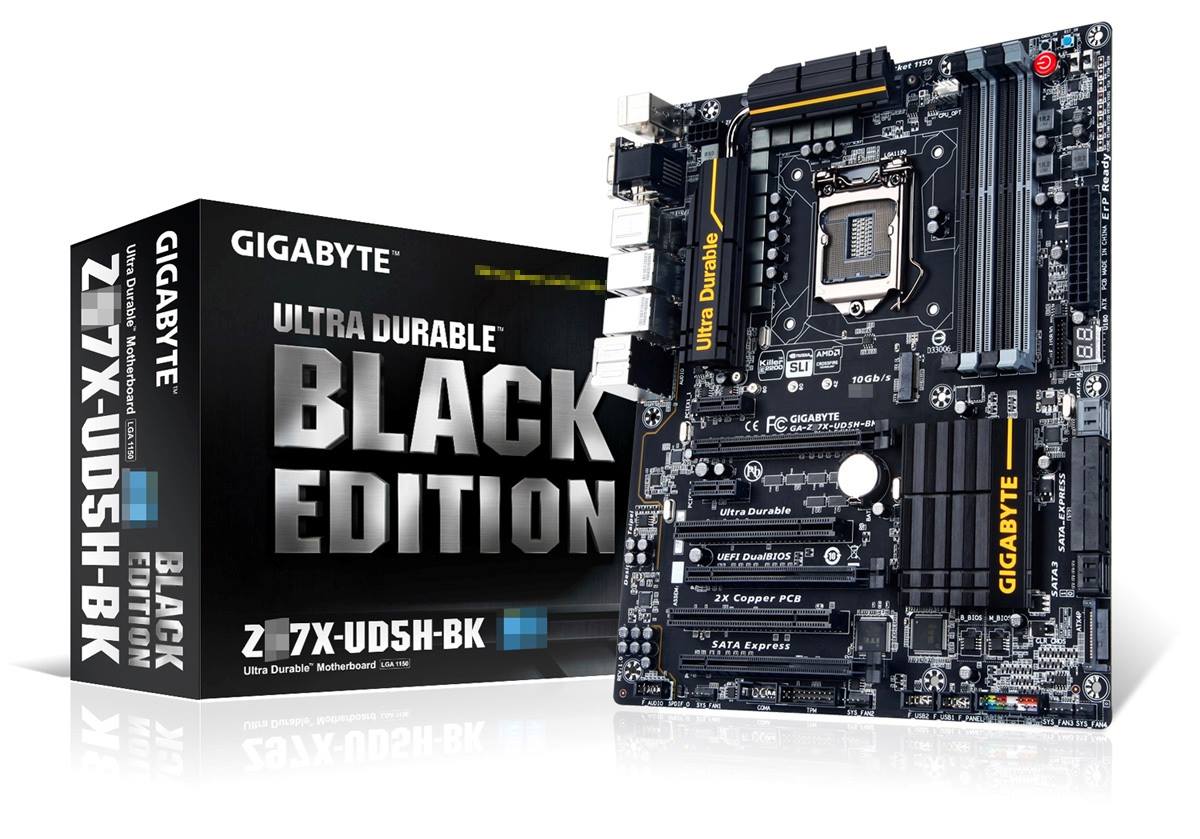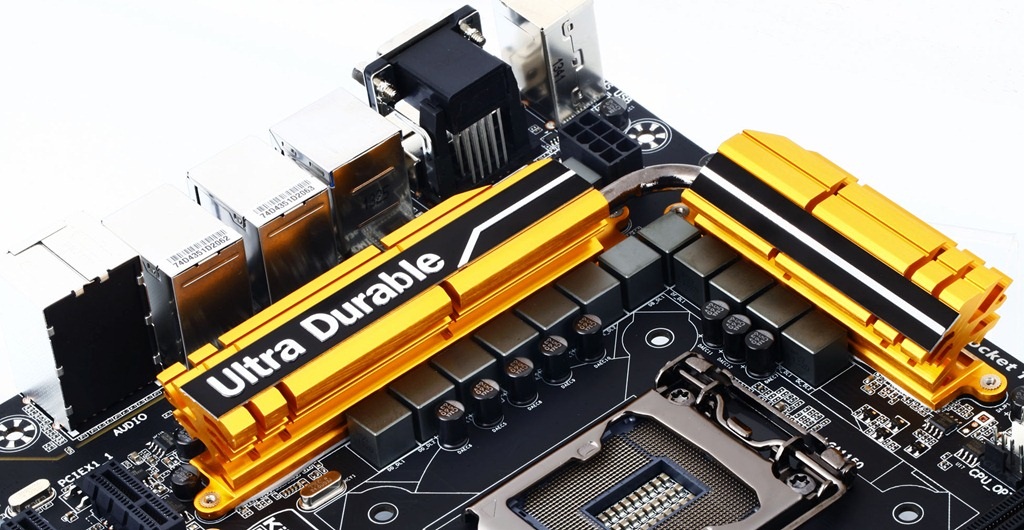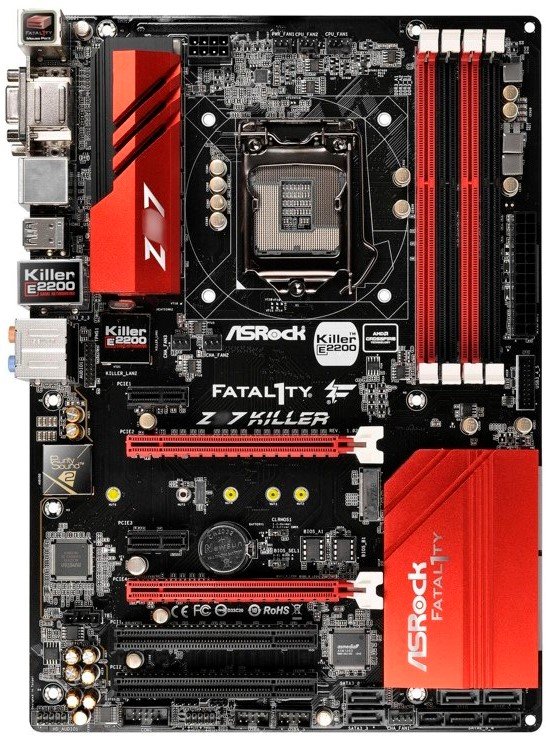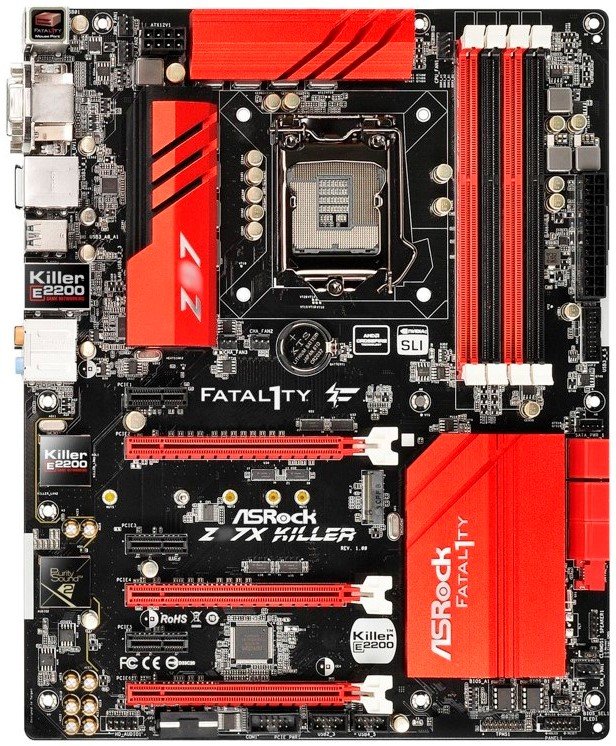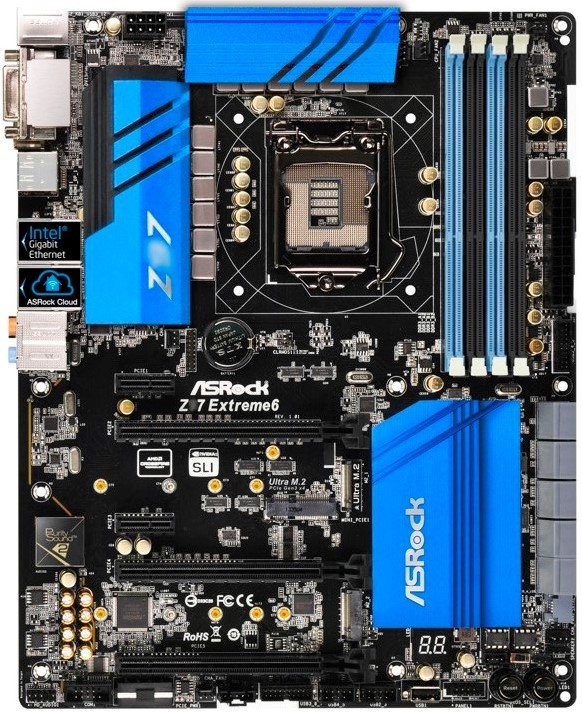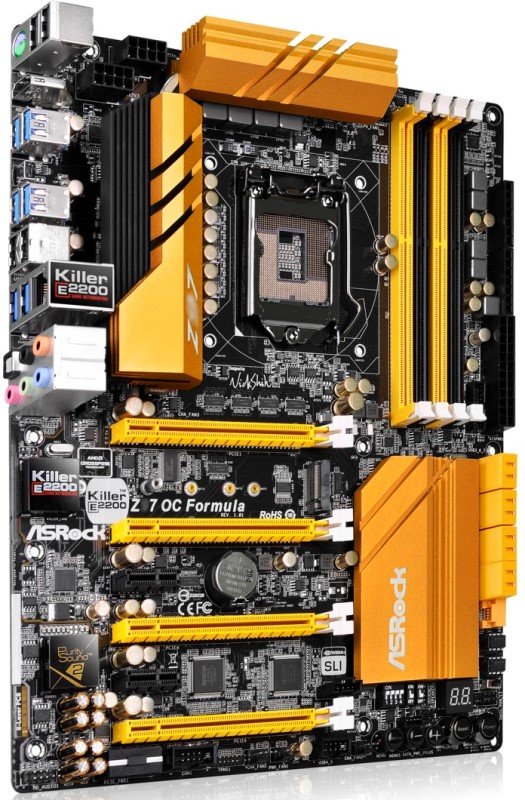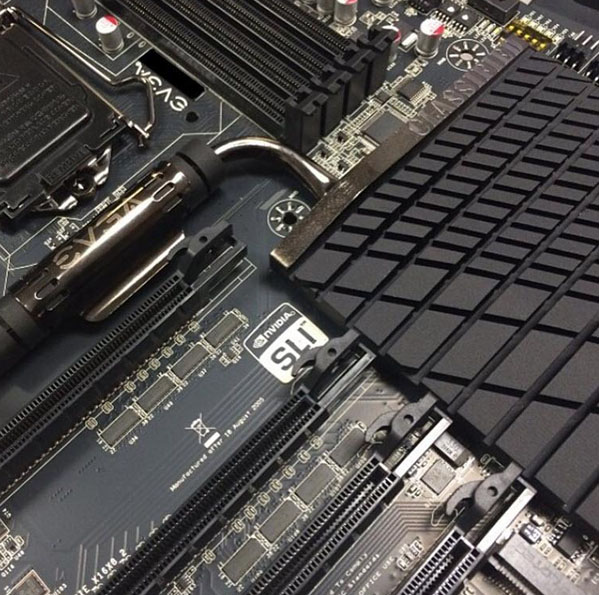With the Haswell refresh CPUs (Devil’s Canyon) coming out and Broadwell planned for later this year, the latest Intel motherboards for them are slowly being leaked through official and unofficial channels. The most notable feature of the new Z97 chipset is that it supports the latest SATA express interface natively, which features transfer speeds of 10-16 Gb/s and enables much faster transfer speeds for SSDs. While motherboard manufacturers aren't releasing official specs just yet, pictures of these upcoming boards have been released and from them we can find out some details.
MSI, ASUS, ASRock, Gigabyte, and EVGA have all posted photos and teaser specs of their Z97 motherboards. In this Z97 Broadwell / Devil’s Canyon motherboard specs round-up, we look at the next generation’s Intel board selection specs and features.
Let’s dive into this.
MSI Broadwell Motherboards
MSI Gaming 3 9-Series Motherboard Specs
This photo reveals MSI’s Gaming 3 (might be Z97, we’re unsure) motherboard, a budget ATX motherboard that could hold solid value if at the correct price point. From this picture we can see what looks like a 6-phase VRM, 1xM.2 port, 6xSATA 6Gb/s ports, 1xUSB 3.0 port, 4xPCIe slot (x16 / x8 / x1 / x1), and 3xPCI slots. MSI’s “Audio Boost” chip can be seen installed in the top left; if it’s anything like what’s found on existing MSI boards, it likely enables 8 channels (7.1) on-board.
The rear IO is unfortunately not seen, but we can see that it includes what looks like a full DTS-enabled audio output, standard LAN, an on-board VGA out, HDMI out, at least 1xUSB3.0 port, and other items that we can’t identify with certainty from this angle.
MSI Gaming 5 9-Series Motherboard Specs
As with MSI’s Gaming 3 board, the Gaming 5 9-series motherboard is quite revealing of its features with a top-down shot. This ATX board appears to include an 8-phase VRM, voltage checkpoints (for those of you requiring perfect control over voltage), 6xSATA 6Gb/s ports, 1xM.2 port, 1xUSB 3.0 port (angled, which helpful seeing as USB 3.0 connectors are often troublesome), a debug readout (seven-segment display) at the bottom of the board, and 7xPCIe slots (x16 / x8 / x8 / x1 / x1 / 1x / 1x) which could be useful in multi-card SLI / CrossFire arrays. The same Audio Boost chip is present on this board.
Although the rear IO is concealed like the previous motherboard, this board has better labeling on the board, so luckily from this we can see some of what its rear IO includes: HDMI, audio out, a number of USB ports, ethernet, VGA out, and what looks to be a PS/2 port all are included in the rear IO. So, as expected, no surprises.
MSI Gaming 7 Z97 Motherboard Specs
Similar to the previous motherboard, MSI’s Gaming 7 motherboard appears to support tri-GPU rigs through 1xPCIe x16 slot and 2xPCIe x8 slots. This ATX motherboard also comes equipped with voltage checkpoints, a beefy 12-phase VRM, 8xSATA 6Gb/s ports, 1xM.2 port, 1xUSB 3.0 port (angled), 7xPCIe slot (x16 / x8 / x8 / x1 / x1 / 1x / 1x), a debug display, and power on, reset, and OC Genie buttons. The Audio Boost chip has shifted a bit, but is still present.
Rear IO labeling shows nothing different, although we can tell it doesn't have VGA out which likely means it has HDMI out.
MSI Gaming 9 Z97 Motherboard Specs
MSI’s Gaming 9 appears to support SLI/CrossFire rigs through 1xPCIe x16 slot and 2xPCIe x8 slots. Again, this is an ATX form factor motherboard using a black PCB and what appears to be placeholder heatsinks (often found on preview boards). As with the previous models, it’s got voltage checkpoints, a 12-phase VRM, 8xSATA 6Gb/s ports, one angled USB 3.0 port,1xUSB 3.0 port, 7xPCIe slots (x16 / x8 / x8 / x1 / x1 / 1x / 1x), an M.2 expansion slot, a debug display, and power on, reset, and OC Genie buttons. There are also two stylish-looking shields over the Audio Boost and IO components, likely serving little purpose beyond branding.
In this photo, the IO is almost completely hidden due to its shield, but we can still tell there are wireless antennas of some variety installed.
MSI Z97I Gaming Mini-ITX Z97 Specs
MSI’s Z97 mini-ITX motherboard holds a good amount of features for something so compact. From the photo, we can see what looks to be a 6-phase VRM, 1xUSB 3.0 port, 6xSATA 6Gb/s ports, and 1xPCIe x16 slot.
The rear IO has wifi antenna ports, ethernet, USB 3.0, HDMI out, DisplayPort out, and audio out.
One thing to note is how close the CPU socket is to the PCIe slot; this could lead to problems with large (or even medium) sized CPU coolers not fitting when a GPU is installed.
MSI Gaming 9 AC Z97 Motherboard Specs
This motherboard appears to be completely identical to the regular Gaming 9 other than its name. I cannot see anything different. We’ll have to wait in order to see what differentiates these motherboards. If you know of any difference, please tell us in the comments below!
ASUS Mainstream Broadwell Lineup
ASUS Z97-A Motherboard Specs
ASUS’ naming convention can be a bit confusing. You can learn more about the pro, expert, deluxe, and other model names in our ASUS naming convention explanation.
Unfortunately, we couldn’t find pictures of all of ASUS’ boards, but we do have their lineup from the Z97-A and up.
 ASUS board shots from here (source).
ASUS board shots from here (source).
From this photo it looks like this ATX board features an 8-phase VRM, 4xSATA 6Gb/s ports, 1xUSB 3.0 port, 5xPCIe slots (x16 / x8 / x8 / x1 / x1), 1xM.2 port, 2xPCI slots, 1xSATA Express port, and Crystal Sound 2.
The rear IO looks to have audio out (potentially including optical), PS/2, VGA out, USB3.0, and DVI-D out, among other things.
ASUS Z97-Pro Motherboard Specs
From what we can see from this picture, it appears the ATX Z97-Pro will feature at least a 6-phase VRM (I would guess in total it’s a 12-phase VRM), 6xSATA 6Gb/s ports, 1xUSB 3.0 port, 1xM.2 port, 7xPCIe slots (presumably x16 / x8 / x8 / x1 / x1 / x1 / x1), 1xSATA Express port, and Crystal Sound 2 (although it is hard to tell).
The rear IO, while hidden, is also showing in the previous picture, allowing us to see what looks like audio out, VGA out, component video out, and PS/2.
On the bottom right of the IO, next to the VRM heatsink, there appears to be an unidentified connector, but we can’t see this clearly enough to confidently identify it. If you think you know what it is, let us know in the comments!
ASUS Z97I-Pro Motherboard Specs
This mini-ITX version of the Z97-Pro looks to be equipped with a 6-phase VRM, a half mini PCI express slot (like those used for laptop adapters), 6xSATA 6Gb/s ports, 1xUSB 3.0 port, and 1xPCIe (x16) slot.
The rear IO appears to have a DVI out port, VGA out port, audio out, along with more that we can’t confidently identify.
ASUS Z97-Deluxe Motherboard Specs
The Deluxe is ASUS’ high-end offering for mainstream chipsets, and just as in the past, this motherboard looks to use high-quality components. We can see what looks like a 12-phase VRM, 2xUSB 3.0 ports, 6xSATA 6Gb/s ports, 2xSATA Express port, 7xPCIe slots (x16 / x8 / x8 / x1 / x1 / x1 / x1), 1xM.2 port, Crystal Sound 2, and the usual power buttons.
The rear IO appears to include audio out and wireless antenna ports. Other than that, the rest is hidden so we can only speculate on it.
ASUS Z97-WS (Workstation) Specs
ASUS’ workstation motherboard looks to be quite a feature-rich motherboard. From this picture, it appears to include 7xPCIe slots (x16 / x16 / x8 / x8 / x4 / x1 / x1), an 8 phase VRM, 2xUSB 3.0 ports, 4xSATA 6Gb/s, 2xSATA Express ports, an M.2 slot, reset and power on buttons, and additional 6-pin and 8-pin power connectors to go along with the usual 8-pin and 24-pin connectors. The additional power connectors are of the most interest and will likely be used to supply additional power for extreme CPU & GPU overclocks.
The rear IO looks to include audio out, but other than that we’re not confident enough to try and name anything else on the rear IO.
ASUS ROG Gene Z97 Specs
Despite the low quality picture, it appears as though the Maximus VII Gene will come equipped with 8xSATA ports (presumably all 6Gb/s), 3xPCIe slots (likely x16 / x8 / x1), and what looks to be start and reset buttons. The Gene is ASUS’ entry-level enthusiast board and is normally priced close to $200. It’s outfitted with a fairly extremely VRM heatsink and ASUS’ red/black ROG branding.
Rear IO interestingly appears to include thunderbolt, ethernet, 4xUSB 3.0 ports, and 2xUSB 2.0 ports.
ASUS ROG Ranger Z97 Specs
The micro-ATX Ranger hosts 6xSATA ports (presumably all 6Gb/s), an 8-phase VRM (or possibly 12 -- the photo makes it hard to tell), 6xPCIe slots (x16 / x8 / x8 / x1 / x1 / x1), and what looks to be start and reset buttons.
The rear IO is unfortunately hidden so we can't guess at what interesting features it has.
ASUS ROG Hero Z97 Specs
And finally we meet the Hero -- the last of our ROG motherboard speculation. This ATX motherboard hosts 6xPCIe slots (x16 / x8 / x8 / x1 / x1 / x1), 8xSATA ports (presumably all 6Gb/s), and what seems to be start and reset buttons.
ASUS Sabertooth Z97 Motherboard Specs
Despite this being a bad picture of the ATX Sabertooth Z79 board, from it we can see what looks to be a 6-phase VRM, 6xPCIe slots (x16 / x8 / x8 / x1 / x1 /x1), 2xSATA Express ports, 6xSATA 6Gb/s ports, and a motherboard fan likely for PEX/PLX cooling for PCI-e lane multiplexing. As with all of ASUS’ TUF boards, the fan will pump cool air through the thermal armor, working to cool down the VRM, chipset, PEX/PLX chips (if present), and other OC components.
The rear IO is completely hidden so we have no way of knowing what it includes.
Gigabyte Broadwell Motherboards
GA-Z97X-G1 Gaming Wi
The ATX Gigabyte Z97X-G1 from this picture looks to have an 8-phase VRM, 7xPCIe slots (x16 / x16 / x8 / x8 / x1 / x1 / x1), 1xUSB 3.0 port (angled), 6xSATA ports (most likely 2x 3Gb/s and 4x 6Gb/s), 2xSATA Express ports, voltage checkpoints, a debug display, and a power on button.
The rear IO of this board looks to have audio out, DVI out, and Killer ethernet, but other than that we can’t tell.
One unique feature about this board appears to be the watercooling threads in the VRM heatsinks, which likely allows it to be cooled easily in a watercooling loop.
GA-Z97X-SOC Force Motherboard Specs
From this picture the Z97X SOC FORCE appears to have an 8-phase VRM, voltage checkpoints, 2xPCI slots, 5xPCIe slots (x16 / x8 / x8 / x8 / x1), 2xSATA 6Gb/s ports, 2xSATA Express ports, 1xUSB 3.0 port, a debug display, and a multitude of buttons used for configuring CPU overclocks. It should be noted that this board has the usual 24- and 8-pin power connections along with another 6-pin and 4-pin connection.
The rear IO includes Killer Ethernet, audio out, DVI out, VGA out, and HDMI out, other than that we cannot tell what the ports are.
GA-Z97X-UD7 TH (Thunderbolt 2) Motherboard Specs
Gigabyte’s Z97X-UD7 TH board hosts an 8-phase VRM, 6xPCIe slots (x16 / x8 / x4 / x1 / x1 / x1), 2xSATA Express ports, 4xSATA ports (with it likely being 2x 3Gb/s and 2x 6Gb/s), 1xUSB 3.0 port, an M.2 port, a power button, and their latest Sound Core 5 design which is meant to improve audio quality, somewhat similar to ASUS’ Crystal Sound tech.
Rear IO hosts DVI out, VGA out, and audio out, but that’s all we can see here. It is almost guaranteed that Thunderbolt 2 will be on this board.
GA-Z97X-UD5H Motherboard Specs
Moving to Gigabyte’s Z97X-UD5H board, this one looks to have a 12-phase VRM, 5xPCIe slots (x16 / x8 / x4 / x1 / x1), 2xPCI slots, 2xSATA Express ports, voltage checkpoints, 4xSATA ports (likely being 2x 3Gb/s and 2x 6Gb/s), an M.2 port, 1xUSB 3.0 port, a debug display, and a power on button.
The rear IO isn't visible in this photo but it is obvious there will be VGA out, if you’re clinging to those cables.
Unknown
This one was spoiled by Gigabyte, but doesn’t yet have any released branding or specifications listings. This motherboard looks almost identical to the Z97X-UD5H, but has heatsinks like the Z97X-UD7 TH, so either this was an earlier prototype of one of these boards or this board is the higher-end variant of the Z97X-UD7 TH.
ASRock Broadwell Motherboards
FATAL1TY Z97 Killer Motherboard Specs
ASRock’s new design features “stop sign red” highlights (which, to be honest, don’t look all that great in these photos) and a black PCB with gold/bronze-colored capacitors.
ASRock’s carefully-shaped, not-at-all-a-9 blur makes it easy to tell that this is a Z97 board. In their lineup, first we have the FATAL1TY Z97 Killer board -- equipped with a Killer NIC and Fatal1ty branding. It looks to have an 8-phase VRM, 4xPCIe slots (x16 / x4 / x1 / x1), 4xSATA 6Gb/s ports, 1xSATA Express port, 1xUSB 3.0 port, and Killer Ethernet.
The rear IO is quite clear and appears to have audio out, 4xUSB 3.0 ports, ethernet, 4xUSB 2.0 ports, DVI out, VGA out, HDMI out, and a PS/2 port.
FATAL1TY Z97X Killer Motherboard Specs
The FATAL1TY Z97X Killer appears to simply be an upgraded version on the regular Killer. According to this photograph, this motherboard has an 8-phase VRM, 6xPCIe slots (16x / x8 / x4 / x1 / x1 /x1), 6xSATA 6Gb/s ports, Killer ethernet, 1xUSB 3.0 port, and a molex power connector at the bottom of the board that appears to be for the PCIe slots.
The rear IO includes audio out, killer ethernet, 4xUSB 3.0 ports, HDMI out, DVI out, VGA out, 4xUSB 2.0 ports, and a PS/2 port.
Interestingly this motherboard lacks a SATA Express port unlike the regular Killer, which is definitely a key feature. It seems like a strange cut in a higher-tier product.
Z97 Extreme 4 Motherboard Specs
The blue/black look is a bit less violent on ASRock’s mainstream boards.
According to these pictures, the Extreme 4 brings a stylish new look to the table (one that even goes with eyes) and also has a 12-phase VRM, 6xPCIe slots (x16 / x8 / x4 / x1 / x1 / x1), a molex power connector for presumably the PCIe power, 1xUSB 3.0 port, 8xSATA ports (which appear to all be 6Gb/s), 1xM.2 port, a debug display, and reset and start buttons.
Rear IO features Intel gigabit ethernet, audio out, 6xUSB 3.0 ports, HDMI out, Displayport out, VGA out, DVI out, 2xUSB 2.0 ports, and a PS/2 port.
Z97 Extreme 6 Motherboard Specs
The Extreme 4’s bigger brother is the Extreme 6. In these pictures, it’s showing off its 12-phase VRM, 5xPCIe slots (x16 / x8 / x4 / x1 / x1), 14xSATA 6Gb/s ports, 1xUSB 3.0 port, a molex port near the bottom, 1xM.2 port, a debug display, and power and reset buttons.
The rear IO includes audio out, 6xUSB 3.0, ASRock Cloud, Intel gigabit ethernet, Displayport out, HDMI out, DVI out, and a PS/2 port.
ASRock Z97 OC Formula Specs
Asrock’s Z97 OC Formula appears to be a feature rich motherboard at first glance, and according to these photos that seems to ring true. The OC Formula features a 12-phase VRM, 6xPCIe slots (x16 / x16 / x16 / x16 / x1 / x1), 1xPCIe 3.0 port, voltage checkpoints, 8xSATA 6Gb/s ports, a debug display, 1xM.2 port, a molex port, and finally control buttons (power on, reset, and menu).
By looking at the IO panel we can easily see that it features audio out for multiple channels (including optical), 6xUSB 3.0, 4xUSB 2.0, Killer ethernet, HDMI out, and a PS/2 port.
ASRock Z97E-ITX AC Specs
The Z97E-ITX /ac is Asrock’s mini-ITX board. In this picture, we can see it has a 6-phase VRM, 1xmSATA port (occupied by what is most likely a network card), 6xSATA 6Gb/s ports, 1xSATA Express port, 1xUSB 3.0 port, and 1xPCIe slot (x16). A wireless adapter is included with the board.
In these pictures we can see the rear IO includes auido out, 4xUSB 3.0, 2x USB 2.0, Intel gigabit ethernet, HDMI out, Displayport out, wifi antenna ports, and a PS/2 connector.
EVGA Broadwell Motherboard
EVGA Classified Z97 Motherboard
EVGA recently leaked a photo of their flagship motherboard. This picture doesn’t show a whole lot, but the motherboard will at least have 1xM.2 ports (or more), 4xPCIe slots (at least) all at x16, voltage checkpoints, and angled fan headers. So really this just tells us is that EVGA is continuing to make motherboards.
And with that, we conclude our coverage of the new 9-series boards. These are some of the Z97 motherboards made for the impending Haswell Refresh (Devil’s Canyon) and Broadwell platforms. Although the Z97 chipset offers a good amount of new features, the most relevant is SATA Express, which will finally free us from the SATA III transfer speeds.
If you have any questions/comments, please post them below!
- Michael "The Bear" Kerns.
